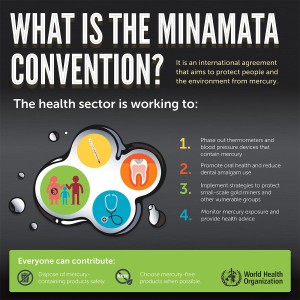BSEF at the Second meeting of the Conference of the Parties to the Minamata Convention on Mercury (COP2)
The second meeting of the Conference of the Parties to the Minamata Convention on Mercury (COP2) took place from 19 to 23 November 2018 at the International Conference Centre in Geneva, Switzerland.
With about 150 national representatives, COP2 aimed to strengthen global efforts to reduce mercury emissions and eliminate adverse effects.
BSEF took place at the meeting as an observer and we had the opportunity to interact with participants and present some of the bromine based mercury emission reduction technologies on the exhibition area.
In fact, Bromine, based products can reduce mercury emissions from coal-fired power plants and another industrial installation in excess of 90%. Coal combustion is today the responsible for a quarter of mercury releases to the atmosphere, while the clinker cement, ferrous and non-ferrous industry sectors account for another quarter.
BSEF believes that it is important to address of all of these sources and to actively search for solutions to the mercury reduction challenges.
The Minamata Convention on Mercury
 Mercury is a global environmental pollutant that may cause neurotoxicity, posing threats to both humans and wild life. World Health Organization even considers mercury one of the top 10 chemical threat to our health. Thus, UN Environment called for a global reaction, Minamata Convention, in October 2013
Mercury is a global environmental pollutant that may cause neurotoxicity, posing threats to both humans and wild life. World Health Organization even considers mercury one of the top 10 chemical threat to our health. Thus, UN Environment called for a global reaction, Minamata Convention, in October 2013
The Minamata Convention on Mercury aims to protect human health and the natural environment on a global basis from artificially emitted or released mercury and its compounds, comprehensively controlling the entire life-cycle of mercury consisting of mining, trading, use, emission, release, disposal and other processes.
Read more about the global treaty here.
COP 2 – Organizational arrangements and Key Outcomes
In contrast to COP 1, COP 2 built on the technical work already in place, setting up the intersessional activities to ensure parties will have the tools to implement the Convention.
COP2 laid the groundwork for COP 3 to adopt strong decisions on issues such as effectiveness evaluation, mercury waste thresholds, contaminated sites, and interim storage of mercury waste. Aware that following COP 3 parties would cease annual meetings and only come together biennially, delegates used COP 2 to set the process in motion to accomplish the phase-out of manufacture and trade in mercury-added products by 2020. The Conference officially determined two organizational details concerning arrangements of the secretariat, locating the secretariat in Geneva, Switzerland and operating the secretariat as an independent organization in cooperation and coordination with the secretariat of the three other conventions for wastes and chemicals, i.e., the Basel, Rotterdam and Stockholm Conventions (BRS), and other entities.
The Conference agreed on advancement of review of the financial mechanism concerning the Minamata Convention, i.e., the Global Environment Facility Trust Fund and the Specific International Programme (SIP) to Support Capacity-building and Technical Assistance in accordance with the provisions of the Minamata Convention. With regard to the SIP, the secretariat provided a briefing on completed preparation of the rules of procedures and the guidance for project examination and on the adoption of the first project.
Concerning the budget for the secretariat, the Conference decided on the appropriation of the 2018 carryover budget for the shortfall in light of the estimated expenditures in 2019.
Delegates were pleased with the increase in funding in the Specific International Programme (SIP). With agreement on the Secretariat, Switzerland requested UNEP to release the CHF 1 million it has been holding in trust since COP 1 for capacity building projects submitted to the SIP. Norway also announced a USD 1 million contribution.
Technical matters
(1) Guidelines on the environmentally sound interim storage of mercury other than waste mercury
The draft guidelines, which have been discussed by the nominated experts since the convening of COP1, were submitted to COP2. The parties reflected their respective opinions in the draft guidelines and adopted it.
(2) Mercury waste thresholds
The parties held discussions on defining target scopes of mercury waste under the Minamata Convention and decided that they will setup an expert meeting after COP2 and advance related tasks in preparation for the convening of COP3.
(3) Effectiveness evaluation of the Minamata Convention
The parties held discussions on the criteria for evaluation that is a requirement under the framework for evaluation included in the Minamata Convention. An expert committee established at COP1 submitted a report on the issue to COP2 and the parties decided that they will continue to advance related tasks in preparation for the convening of COP3.
(4) Guidance on the management of contaminated sites
The parties held discussions on the draft guidance which is an outcome of the efforts by the secretariat of the Minamata Convention in collaboration with experts, and they decided that the secretariat will collect additional information, undertake a new call for opinions from experts and continue to advance tasks aiming at the adoption of the guidance at COP3.
(5) Guidance in relation to mercury releases
Concerning the identification of sources of mercury released into water and soil and the listing of sources, the parties decided that they will establish an expert group to begin related work.
The third meeting of the Conference of the Parties to the Minamata Convention on Mercury COP3 will be held in Geneva, Switzerland, in November 2019.
References:
Ministry of trade and Industry of Japan
The United Nations Industrial Development Organization (UNIDO)
UN Environment


